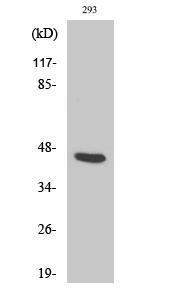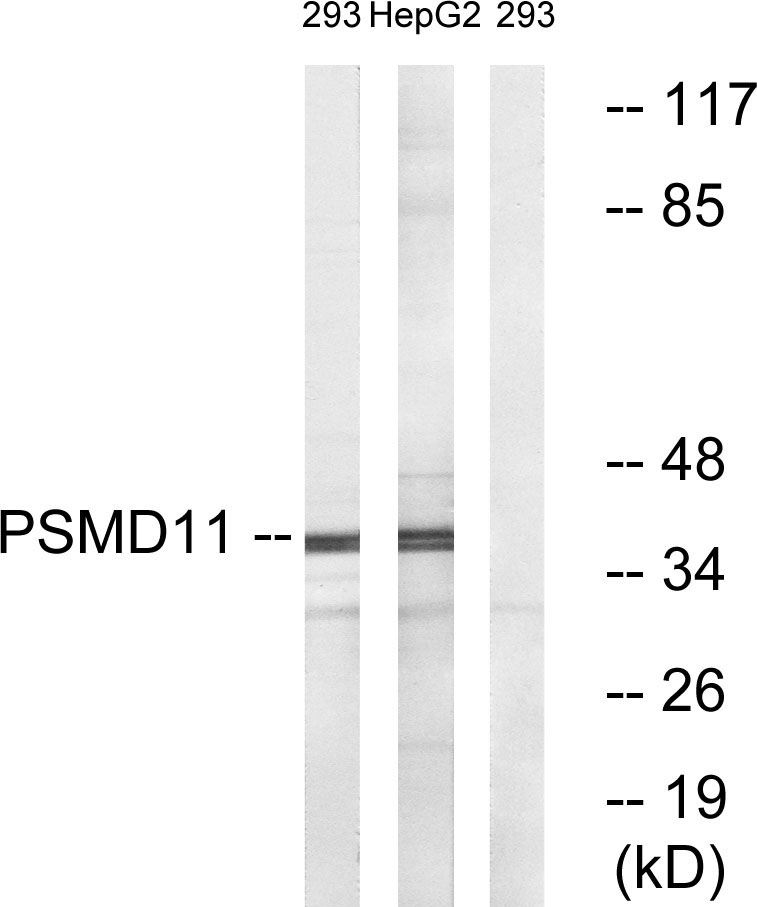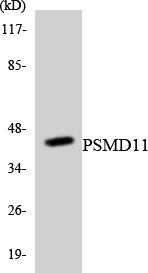PSMD11 Polyclonal Antibody
- Catalog No.:YT3886
- Applications:WB;IHC;IF;ELISA
- Reactivity:Human;Mouse
- Target:
- PSMD11
- Fields:
- >>Proteasome;>>Alzheimer disease;>>Parkinson disease;>>Amyotrophic lateral sclerosis;>>Huntington disease;>>Spinocerebellar ataxia;>>Prion disease;>>Pathways of neurodegeneration - multiple diseases;>>Epstein-Barr virus infection
- Gene Name:
- PSMD11
- Protein Name:
- 26S proteasome non-ATPase regulatory subunit 11
- Human Gene Id:
- 5717
- Human Swiss Prot No:
- O00231
- Mouse Gene Id:
- 69077
- Mouse Swiss Prot No:
- Q8BG32
- Immunogen:
- The antiserum was produced against synthesized peptide derived from human PSMD11. AA range:271-320
- Specificity:
- PSMD11 Polyclonal Antibody detects endogenous levels of PSMD11 protein.
- Formulation:
- Liquid in PBS containing 50% glycerol, 0.5% BSA and 0.02% sodium azide.
- Source:
- Polyclonal, Rabbit,IgG
- Dilution:
- WB 1:500 - 1:2000. IHC 1:100 - 1:300. ELISA: 1:10000.. IF 1:50-200
- Purification:
- The antibody was affinity-purified from rabbit antiserum by affinity-chromatography using epitope-specific immunogen.
- Concentration:
- 1 mg/ml
- Storage Stability:
- -15°C to -25°C/1 year(Do not lower than -25°C)
- Other Name:
- PSMD11;26S proteasome non-ATPase regulatory subunit 11;26S proteasome regulatory subunit RPN6;26S proteasome regulatory subunit S9;26S proteasome regulatory subunit p44.5
- Observed Band(KD):
- 42kD
- Background:
- The 26S proteasome is a multicatalytic proteinase complex with a highly ordered structure composed of 2 complexes, a 20S core and a 19S regulator. The 20S core is composed of 4 rings of 28 non-identical subunits; 2 rings are composed of 7 alpha subunits and 2 rings are composed of 7 beta subunits. The 19S regulator is composed of a base, which contains 6 ATPase subunits and 2 non-ATPase subunits, and a lid, which contains up to 10 non-ATPase subunits. Proteasomes are distributed throughout eukaryotic cells at a high concentration and cleave peptides in an ATP/ubiquitin-dependent process in a non-lysosomal pathway. This gene encodes a member of the proteasome subunit S9 family that functions as a non-ATPase subunit of the 19S regulator and is phosphorylated by AMP-activated protein kinase. Alternatively spliced transcript variants have been observed for this gene. [provided by RefSeq,
- Function:
- function:Acts as a regulatory subunit of the 26S proteasome which is involved in the ATP-dependent degradation of ubiquitinated proteins.,similarity:Belongs to the proteasome subunit S9 family.,similarity:Contains 1 PCI domain.,subunit:Component of the PA700 complex.,
- Subcellular Location:
- Nucleus . Cytoplasm, cytosol .
- Expression:
- Highly expressed in embryonic stem cells (ESCs). Expression decreases as ESCs differentiate.
- June 19-2018
- WESTERN IMMUNOBLOTTING PROTOCOL
- June 19-2018
- IMMUNOHISTOCHEMISTRY-PARAFFIN PROTOCOL
- June 19-2018
- IMMUNOFLUORESCENCE PROTOCOL
- September 08-2020
- FLOW-CYTOMEYRT-PROTOCOL
- May 20-2022
- Cell-Based ELISA│解您多样本WB检测之困扰
- July 13-2018
- CELL-BASED-ELISA-PROTOCOL-FOR-ACETYL-PROTEIN
- July 13-2018
- CELL-BASED-ELISA-PROTOCOL-FOR-PHOSPHO-PROTEIN
- July 13-2018
- Antibody-FAQs
- Products Images

- Western Blot analysis of various cells using PSMD11 Polyclonal Antibody

- Western blot analysis of lysates from 293 and HepG2 cells, using PSMD11 Antibody. The lane on the right is blocked with the synthesized peptide.

- Western blot analysis of the lysates from RAW264.7cells using PSMD11 antibody.

- Immunohistochemical analysis of paraffin-embedded human small intestinal carcinoma tissue. 1,primary Antibody was diluted at 1:200(4° overnight). 2, Sodium citrate pH 6.0 was used for antigen retrieval(>98°C,20min). 3,Secondary antibody was diluted at 1:200



